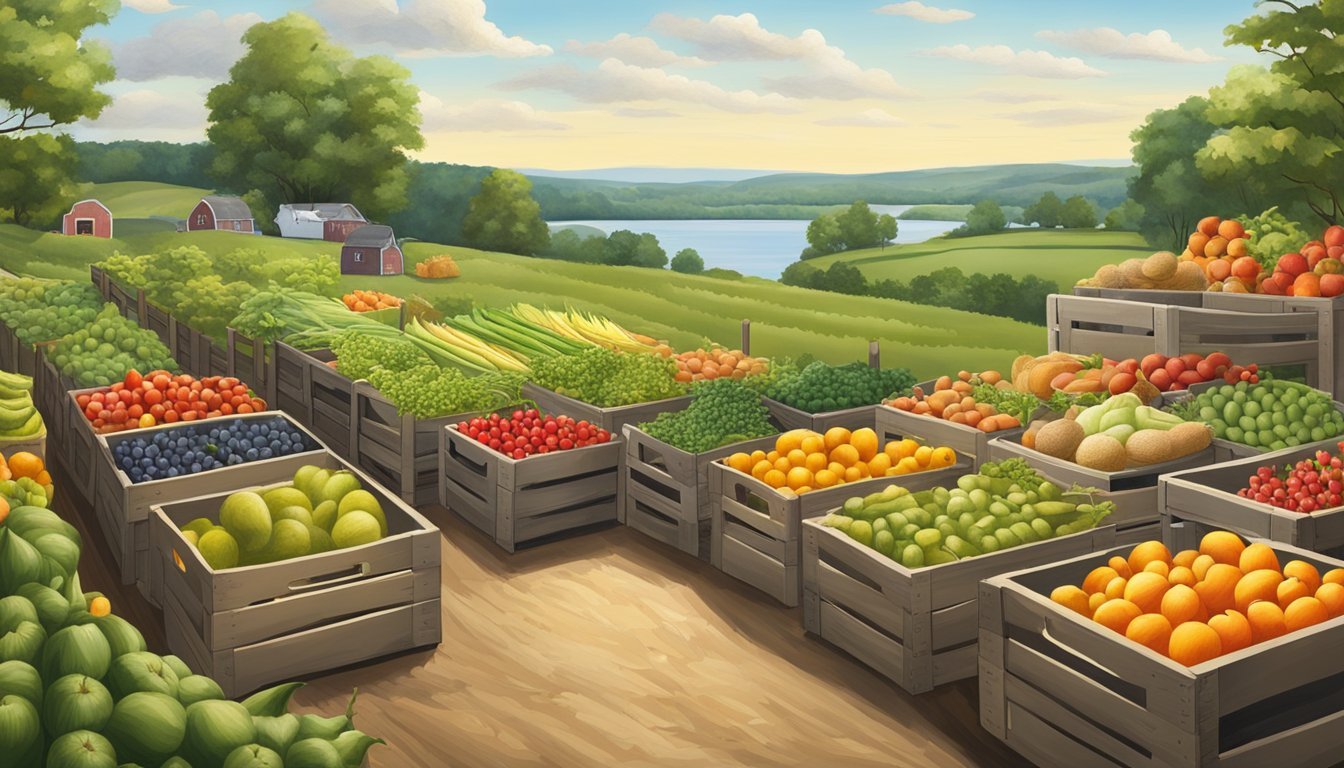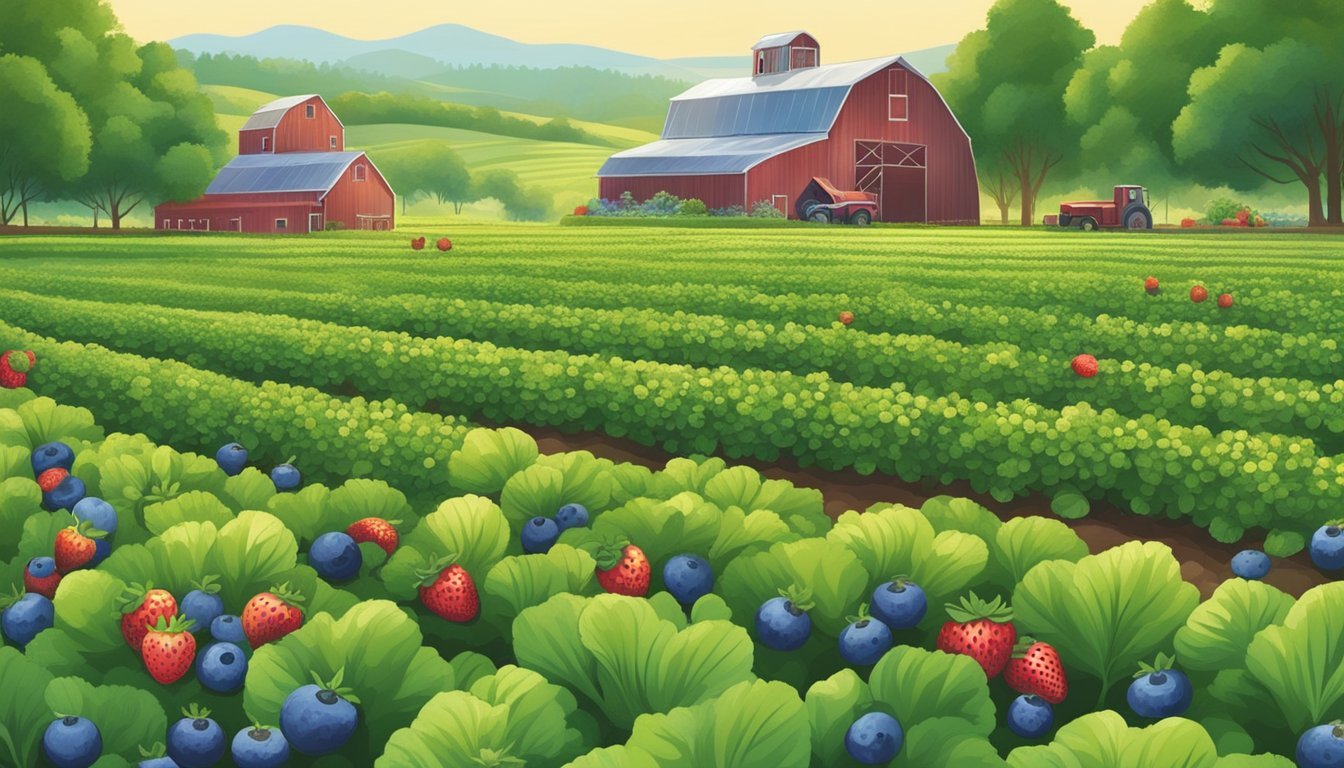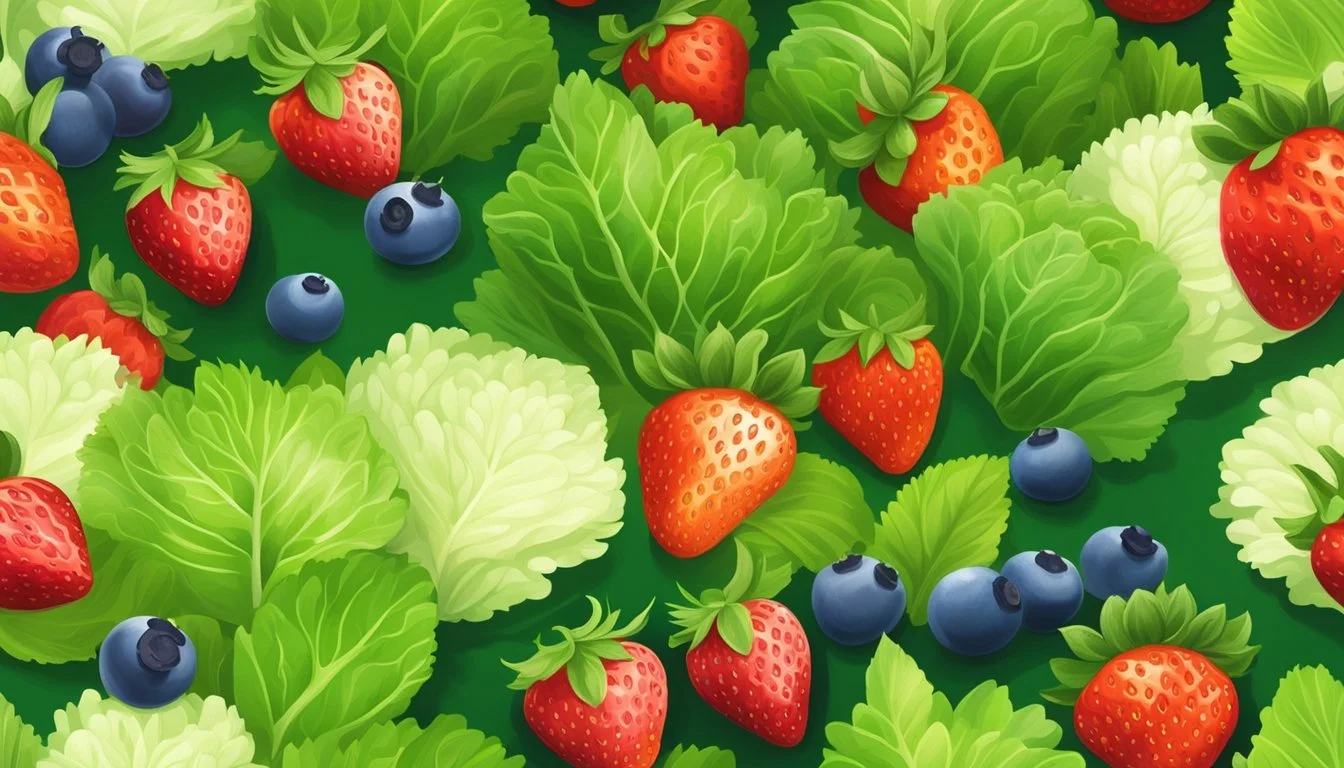Massachusetts Seasonal Fruit & Vegetables in June
Your Summer Produce Guide
This Article is Part of our Massachusetts Seasonal Fruit & Veg Calendar
Massachusetts offers a rich tapestry of fruits and vegetables througout the year, with June being particularly abundant. As the spring's cool embrace warms into the early hints of summer, local farms and gardens begin to yield a variety of produce. Consumers looking to enjoy fresh, locally-grown fruits and vegetables can find an array of options. During this month, farm stands and markets become vibrant displays of the state's agricultural bounty.
In June, the fields and orchards of Massachusetts come alive with fresh produce. Favorites such as strawberries start to reach their peak, providing a sweet treat that's perfect for everything from pies to fresh salads. Vegetables like asparagus (What wine goes well with asparagus?) and green onions also continue their season, offering crisp textures and flavors to a multitude of dishes. The availability of these and other June produce ensures that local cuisine can be infused with the freshest ingredients.
Eating seasonally in Massachusetts not only supports local agriculture but also promises the freshest tastes and nutritional benefits. The cycle of produce is at the heart of many community events, with harvest times dictating local festivals and celebrations. June's selections offer the perfect opportunity for individuals to explore the local flavors and contribute to sustainable food practices by choosing Massachusetts-grown options.
Understanding Seasonality in Massachusetts
Massachusetts experiences a distinctive seasonality, largely influenced by its position in New England. The transition from spring to summer in June brings a pivotal change in local crop availability. Farmers in the state seize the longer daylight hours and warmer temperatures, which are conducive to the growth of various fruits and vegetables.
Typically, the summer season is marked by an increase in harvests of certain crops that enjoy the mild to warm conditions. However, the tail end of spring can still have variable weather patterns, including rain and occasional frost, which may affect crop availability and harvest times.
Local farmers monitor elements such as rain levels, potential frost, and pest activity closely, as these factors are critical in determining the quality and quantity of the produce. They employ their expertise to ensure a successful harvest of the crops that thrive during this juncture of the growing season.
Massachusetts' diverse climate results in a mixture of available produce in June. Here is an overview of local crops typically harvested during this month:
Fruits: Strawberries, Cherries (how long do cherries last?)
Vegetables: Lettuce, Spinach, Radishes, Turnips, Peas, Beets
It's important to understand that crop availability may vary year-to-year due to the dynamic New England weather conditions. Nonetheless, Massachusetts farmers are adept at adapting to these changes to ensure a bountiful harvest for local communities.
June's Harvest Overview
In June, Massachusetts offers a diverse palette of fruits and vegetables fresh from the harvest. The warmer temperatures and fertile soils provide ideal growing conditions for a variety of produce.
Fruits:
Strawberries: Among the first to arrive at farm stands, strawberries in June are known for their sweetness and vibrant red color.
Cherries: These start to become available and can be found fresh and full of flavor.
Vegetables:
Fiddleheads: These uniquely coiled greens have a short season that often extends into June.
Lettuce: Various types of lettuce are abundant, and the leafy greens are particularly tender and flavorful.
Asparagus: Still in season from May, asparagus is at its peak, offering a fresh, earthy taste.
Green Onions/Scallions: These versatile aromatics enhance the flavor profile of many dishes.
Peas: Both green and snap peas are harvested, adding sweetness and crunch.
Farmers' markets become hubs of vibrant activity where the community shops for the freshest local produce. Availability can vary slightly due to weather conditions, but June reliably delivers a bounty that captures the essence of the season. The emphasis on flavor and peak ripeness encourages shopping directly from local growers.
The variety in Massachusetts during June extends to other vegetables such as broccoli, radishes, and green beans, all known for their freshness and contribution to a healthful diet. These selections become stars of seasonal recipes and are a testament to the state's rich agricultural offerings.
Key Vegetables in June
June in Massachusetts heralds the arrival of a variety of fresh, local vegetables. Shoppers can find a range of produce bursting with flavor, thanks to the warm weather that accompanies the onset of summer.
Leafy Greens
In June, leafy greens thrive in the temperate climate. Consumers can expect to find:
Spinach: Rich and tender, perfect for salads and cooking.
Kale: Sturdy and nutrient-packed, ideal for both raw and cooked dishes.
Lettuce: Crisp and fresh, including varieties like romaine and butterhead.
Arugula: (how long does arugula last?) Peppery, adding a zesty kick to any dish.
Chard: Vibrant leaves that work well sautéed or boiled.
Radicchio: With its bitter and spicy taste, radicchio shines in mixed salads.
Root Crops
Root vegetables make a noticeable appearance in June, with several varieties becoming available:
Beets: Sweet and earthy, suitable for roasting or salads.
Carrots: Crunchy and sweet, versatile for many culinary uses.
Turnips: With a sharp, yet slightly sweet flavor, great in stews.
Radishes: Peppery and crisp, perfect for a crunchy snack or salad addition.
Pod Vegetables & Beans
Pod vegetables and beans are just beginning to come into season:
Peas: Including green peas and snap peas, these are sweet and tender.
Green Beans: Fresh and snappy, these beans cook quickly and retain a slight crunch.
Fava Beans: (how long do fava beans last?) Large, flat beans that have a nutty flavor and creamy texture when cooked.
Nightshades and Cucurbits
This subgroup contains some of the most anticipated summer vegetables:
Cucumbers: Cool and crisp, ideal for salads or pickling.
Peppers: Starting to appear, these can range from sweet to spicy.
Summer Squash: Including zucchini, with its tender and slightly sweet flesh.
Eggplant: Begins to be available near the end of June, prized for its creamy texture.
Tomatoes: The early varieties may start to be seen, especially the smaller cherry and grape types.
Alliums
Alliums are essential for adding depth of flavor to many dishes:
Onions: Various types, from sweet to pungent.
Leeks: Mild and onion-like, suitable for both raw and cooked applications.
Garlic: Fresh garlic has a more mellow flavor compared to the dried bulbs.
Green Onions: Also called scallions, offering a mild onion taste that is excellent both raw and cooked.
Featured Fruits of June
In June, Massachusetts celebrates the arrival of berry season and the first wave of stone fruits, offering a bounty of fresh and sweet options.
Berries
Strawberries: They are the stars of the early summer, with their peak season starting in June. They provide a sweet and juicy treat perfect for eating fresh or in desserts.
Blueberries: (how long do blueberries last?) June marks the beginning of blueberry season in Massachusetts, presenting an opportunity to enjoy these antioxidant-rich berries fresh from local farms.
Raspberries: Towards the end of the month, raspberries start to make an appearance, offering their distinctively sweet and slightly tart flavor.
Early Stone Fruits
Cherries: Sweet cherries come into season in June. They are often among the first stone fruits available and can be found fresh at local markets.
Melons: Various types of melons may start to become available, heralding the onset of summer with their refreshing sweetness.
Farmers Market and Farm Stand Culture
In Massachusetts, the heart of summer brings a thriving farmers market and farm stand scene. These markets are communal hubs where local growers proudly offer their freshest harvests. As June unfolds, consumers find an array of vibrant, seasonal produce that signals the true start of summer.
Patrons visiting these markets in June are likely to encounter:
Fruits: Strawberries, cherries, and early raspberries
Vegetables: Zucchini, summer squash, cucumbers, and leafy greens
Farm stands, on the other hand, represent the intimate side of agricultural commerce. They are often family-run and seasonally operated directly on farm properties. Shoppers at these stands enjoy a close connection with the source of their food, engaging with farmers who can provide insights on their produce and farming practices.
These local points of sale are integral for farmers. They provide a direct-to-consumer model that supports sustainable agricultural operations and strengthens the local economy. Additionally, they offer fresh options throughout the harvesting season, with selections diversifying as the summer progresses into July and August.
The culture of these markets is one of community and sustainability. Shoppers value the freshness of the produce, which is often picked within hours of being sold. Moreover, Massachusetts' farm stands and farmers markets foster a shared commitment to local agriculture. They are more than just places to buy food; they are pivotal in maintaining the cultural landscape of New England's food systems, ensuring that the summer months are rich with local flavor and community spirit.
Preparations and Storage for Fresh Produce
When handling fresh produce, the goal is to maximize flavor and longevity. Each fruit and vegetable has specific storage needs to preserve freshness and taste. Here are some general guidelines to ensure the best outcome for June's seasonal bounty in Massachusetts.
Temperature and Humidity Control:
Cold Storage: Refrigerate perishable fruits and vegetables at temperatures between 35-40 degrees Fahrenheit.
Humidity Levels: Certain produce requires higher humidity, so use the crisper drawers if adjustable settings are available.
Preparation Tips:
Cleaning: Gently rinse produce under cold water just before consumption or use.
Trimming: Remove any damaged or bruised areas to prevent the spread of rot.
Storage Practices:
Leafy Greens: Wrap lettuce and other greens in paper towels to absorb excess moisture before refrigerating.
Asparagus: Store upright in a container with an inch of water or wrap ends with a damp paper towel and a plastic bag.
Herbs: Keep herbs like mint fresh by snipping the stems and placing them in a jar with water.
Proper Storage Locations:
Keep fruits and vegetables that emit ethylene gas, like apples and bananas, away from those that are sensitive to it to prevent premature aging.
Preservation Methods:
Freezing: Fruits like berries can be frozen for long-term preservation. Spread them on a tray to freeze individually and then store in airtight containers.
Canning: Acidic fruits are suitable for canning, which can extend the enjoyment of the harvest.
By following these storage and preparation guidelines, consumers can enjoy the peak flavors of Massachusetts's seasonal produce well beyond their harvest dates.
Local Culinary Traditions and Recipes
June in Massachusetts brings a fusion of fresh produce into the local cuisine, emphasizing the rich culinary traditions of the region. As the season blossoms, farmers' markets are abundant with juicy strawberries, crisp lettuces, and tender green peas, crafting a canvas for delicious and nutritious meals.
Massachusetts inspires a bevy of traditional recipes that highlight the tastes of June. Strawberry shortcake, a beloved dessert, showcases sweet, sun-ripened strawberries atop a flaky biscuit, often finished with a dollop of whipped cream. This seasonal delight not only tantalizes the taste buds but also celebrates the first fruit harvest of summer.
Seasonal Salad:
Ingredients Preparation Baby lettuce Toss Fresh peas Mix in Radishes Slice Vinaigrette Drizzle
This salad exemplifies simple elegance, combining the crispness of local greens with the sweetness of fresh peas — an ode to the season's bounty.
Clam chowder, rich and warming, remains a year-round staple, but summer heralds lighter versions. Chefs might use June's fresh herbs, like thyme and parsley, to infuse the classic with a seasonal touch, satisfying both tradition and the desire for something less heavy in the warmer months.
Throughout Massachusetts, these June ingredients contribute to an authentic culinary narrative, where the local flavors and straightforward techniques speak to the heart of the region's food culture.
Healthy Eating and Nutritional Benefits
June in Massachusetts offers a variety of fruits and vegetables that are not only palatable but also packed with nutritional benefits. Consuming locally harvested produce ensures one is getting the freshest and most nutrient-dense options available. These beneficial foods contribute to a healthy and nutritious diet.
Maize, beets, and blueberries are some of the nutritious selections available. These foods are abundant with essential vitamins and minerals. Blueberries, recognized for their high antioxidant levels, can enhance heart health and provide anti-inflammatory effects. Maize, while often enjoyed for its taste, contains valuable B vitamins, iron, and fiber. Beets are a great source of fiber, folate (vitamin B9), manganese, potassium, iron, and vitamin C.
Eating seasonally also implies variety, which is key in a healthy diet as it prevents nutritional deficiencies and promotes a well-rounded intake of micronutrients. Here is a quick glance at some beneficial nutrients found in June’s seasonal produce in Massachusetts:
Fruit/Vegetable Nutrient Benefit Blueberries Antioxidants Supports immune function Spinach Iron Essential for blood health Strawberries Vitamin C Aids in skin health Radishes Potassium Regulates fluid balance
The fiber in these fruits and vegetables assists in maintaining a healthy digestive system, while the variety of vitamins and minerals they contain supports overall well-being. They also play a role in chronic disease prevention by providing phytochemicals that the body needs for proper functioning.
Incorporating fresh, local produce into one's diet is not only a delectable way to enjoy the season but also fortifies one's health through a diverse array of nutrients, supporting local agriculture and contributing to sustainable eating habits.
Agricultural Practices and Sustainability
Massachusetts farmers engage in sustainable farming practices that focus on environmental stewardship during the month of June, which is a peak season for a range of fruits and vegetables. These practices aim to ensure the longevity and health of the agricultural ecosystem while providing a bountiful harvest.
Crop Rotation: Farmers often employ crop rotation to maintain soil health, deter pests, and reduce the need for chemical fertilizers. This results in more nutrient-rich produce for local consumption.
Integrated Pest Management (IPM): IPM strategies are leveraged to minimize pest impact while reducing reliance on pesticides. This method balances the immediate needs for pest control with long-term environmental sustainability.
Water Conservation: Efficient irrigation systems are utilized to conserve water. Techniques include drip irrigation and rainwater harvesting, which are particularly important during dry spells in June.
The adoption of cover crops is another strategy to protect and enhance soil quality. Cover crops, such as clover or rye, are planted during or off-season to prevent soil erosion, improve soil structure, and promote biodiversity.
Farmers in Massachusetts also contribute to local and ecological sustainability by:
Reducing food miles associated with transportation
Supporting the local economy and preserving farmlands
Limiting the environmental impact by decreasing carbon emissions through local distribution
These efforts showcase a clear and confident commitment to ensuring that Massachusetts' agricultural sector flourishes both economically and ecologically, providing high-quality and sustainable produce for local communities.
Looking Forward to July
With the arrival of July in Massachusetts, individuals can expect an abundant array of produce marking the heart of summer's bounty. July offers continuity from June's offerings, yet also brings about a seasonal transition with several new crops reaching their peak.
Local markets will see the beginning of blueberry season, enticing consumers with their fresh, ripe flavors. Peaches begin to make a welcome appearance, providing a juicy, sweet treat. Here’s a breakdown of what to anticipate:
Vegetables:
Tomatoes: Ranging from heirloom varieties to cherry tomatoes.
Summer squash: Including zucchini and yellow squash.
Cucumbers: Perfect for fresh salads or pickling.
Green beans: Snapped fresh off the vine.
Corn: Sweet and ideal for summer barbecues.
Fruits:
Cherries: Offering a short but sweet season.
Raspberries: Come into season by the end of July.
The anticipation grows for these crops as they are not only staples of summer cuisine but also represent the diversification of seasonal menus, inviting creative culinary explorations.
Farmers and gardeners alike monitor the changing weather patterns, ensuring the crops receive optimal care during this crucial growth period. Consumers look forward to the vibrant farmers' markets which showcase the peak of local agriculture.
As the days of July unfold, this eclectic mix of produce provides an enticing palette for both the casual home cook and the professional chef, reinforcing the joy and abundance of Massachusetts' summer season.
Conclusion
In June, Massachusetts showcases a bounty of fresh produce. This period is marked by the arrival of various greens and beans, epitomizing the peak of spring's offerings. Consumers can take pleasure in a range of vegetables that are at their freshest, such as arugula, chard, and fava beans. Notably, the month is also an opportune time to enjoy garlic scapes.
On the fruit front, strawberries often steal the spotlight, presenting themselves as a sweet, seasonal treat. Their availability makes them perfect for a host of dishes, from salads to desserts. They are typically found in local farmers' markets and are a celebrated part of the region's agricultural identity during this time.
Residents and visitors are encouraged to capitalize on these seasonal offerings for the optimal culinary experience. Supporting local agriculture by purchasing seasonally ensures a more flavorful and nutritious diet while bolstering community farmers. Here's a quick view of what's available:
Vegetables:
Arugula (May through September)
Chard (May through November)
Fava beans (May and June)
Garlic scapes (May and June)
Fruits:
Strawberries (June)
As the season progresses, the variety of available produce will evolve, culminating in a diverse array of fresh fruits and vegetables that can be enjoyed throughout the year.












